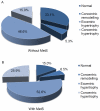The association of left ventricular hypertrophy with metabolic syndrome is dependent on body mass index in hypertensive overweight or obese patients
- PMID: 21304952
- PMCID: PMC3031611
- DOI: 10.1371/journal.pone.0016630
The association of left ventricular hypertrophy with metabolic syndrome is dependent on body mass index in hypertensive overweight or obese patients
Abstract
Background: Overweight (Ow) and obesity (Ob) influence blood pressure (BP) and left ventricular hypertrophy (LVH). It is unclear whether the presence of metabolic syndrome (MetS) independently affects echocardiographic parameters in hypertension.
Methods: 380 Ow/Ob essential hypertensive patients (age ≤ 65 years) presenting for referred BP control-related problems. MetS was defined according to NCEP III/ATP with AHA modifications and LVH as LVM/h(2.7) ≥ 49.2 g/m(2.7) in males and ≥ 46.7 g/m(2.7) in females. Treatment intensity score (TIS) was used to control for BP treatment as previously reported.
Results: Hypertensive patients with MetS had significantly higher BMI, systolic and mean BP, interventricular septum and relative wall thickness and lower ejection fraction than those without MetS. LVM/h(2.7) was significantly higher in MetS patients (59.14 ± 14.97 vs. 55.33 ± 14.69 g/m(2.7); p = 0.022). Hypertensive patients with MetS had a 2.3-fold higher risk to have LVH/h(2.7) after adjustment for age, SBP and TIS (OR 2.34; 95%CI 1.40-3.92; p = 0.001), but MetS lost its independent relationship with LVH when BMI was included in the model.
Conclusions: In Ow/Ob hypertensive patients MetS maintains its role of risk factor for LVH independently of age, SBP, and TIS, resulting in a useful predictor of target organ damage in clinical practice. However, MetS loses its independent relationship when BMI is taken into account, suggesting that the effects on MetS on LV parameters are mainly driven by the degree of adiposity.
Conflict of interest statement
Figures
Similar articles
-
Features of left ventricular hypertrophy in patients with metabolic syndrome with or without comparable blood pressure: a meta-analysis.Endocrine. 2013 Jun;43(3):548-63. doi: 10.1007/s12020-013-9883-4. Epub 2013 Jan 31. Endocrine. 2013. PMID: 23371816
-
Microalbuminuria and left ventricular mass in overweight and obese hypertensive patients: role of the metabolic syndrome.High Blood Press Cardiovasc Prev. 2011 Dec 1;18(4):195-201. doi: 10.2165/11593650-000000000-00000. High Blood Press Cardiovasc Prev. 2011. PMID: 22283674
-
Investigation of the prevalence of cardiovascular risk factors in obese patients diagnosed with metabolic syndrome in childhood and examination of left ventricular function by echocardiography.J Pediatr Endocrinol Metab. 2021 Apr 27;34(7):885-896. doi: 10.1515/jpem-2020-0597. Print 2021 Jul 27. J Pediatr Endocrinol Metab. 2021. PMID: 33901387
-
Combination of hyperuricemia and metabolic syndrome is an independent and powerful predictor for left ventricular hypertrophy in rural Chinese.Ann Endocrinol (Paris). 2015 Jul;76(3):264-71. doi: 10.1016/j.ando.2015.01.002. Epub 2015 Jun 30. Ann Endocrinol (Paris). 2015. PMID: 26141680
-
What Is the Effect of Metabolic Syndrome without Hypertension on Left Ventricular Hypertrophy?Echocardiography. 2016 Sep;33(9):1284-9. doi: 10.1111/echo.13247. Epub 2016 Apr 24. Echocardiography. 2016. PMID: 27109543
Cited by
-
Features of left ventricular hypertrophy in patients with metabolic syndrome with or without comparable blood pressure: a meta-analysis.Endocrine. 2013 Jun;43(3):548-63. doi: 10.1007/s12020-013-9883-4. Epub 2013 Jan 31. Endocrine. 2013. PMID: 23371816
-
Relationship of body fat and left ventricular hypertrophy with the risk of all-cause death in patients with coronary artery disease.J Geriatr Cardiol. 2022 Mar 28;19(3):218-226. doi: 10.11909/j.issn.1671-5411.2022.03.002. J Geriatr Cardiol. 2022. PMID: 35464645 Free PMC article.
-
Single-pill fixed-dose drug combinations to reduce blood pressure: the right pill for the right patient.Ther Adv Chronic Dis. 2022 Jun 24;13:20406223221102754. doi: 10.1177/20406223221102754. eCollection 2022. Ther Adv Chronic Dis. 2022. PMID: 35769133 Free PMC article. Review.
-
Proportionality at birth and left ventricular hypertrophy in healthy adolescents.Early Hum Dev. 2019 May;132:24-29. doi: 10.1016/j.earlhumdev.2019.03.018. Epub 2019 Apr 3. Early Hum Dev. 2019. PMID: 30953878 Free PMC article.
-
Risk factors for increased left ventricular hypertrophy in patients with chronic kidney disease.Clin Exp Nephrol. 2013 Oct;17(5):730-742. doi: 10.1007/s10157-012-0758-4. Epub 2013 Jan 16. Clin Exp Nephrol. 2013. Retraction in: Clin Exp Nephrol. 2017 Dec;21(6):1146. doi: 10.1007/s10157-017-1466-x. PMID: 23318981 Free PMC article. Retracted.
References
-
- Poirier P, Giles TD, Bray GA, Hong Y, Stern JS, et al. American Heart Association; Obesity Committee of the Council on Nutrition, Physical Activity, and Metabolism. Obesity and cardiovascular disease: pathophysiology, evaluation, and effect of weight loss: an update of the 1997 American Heart Association Scientific Statement on Obesity and Heart Disease from the Obesity Committee of the Council on Nutrition, Physical Activity, and Metabolism. Circulation. 2006;113:898–918. - PubMed
-
- MacMahon S, Alderman MH, Lindholm LH, Liu L, Sanchez RA, et al. Blood-pressure-related disease is a global health priority. Lancet. 2008;371:1480–1482. - PubMed
-
- Cutler JA, Sorlie PD, Wolz M, Thom T, Fields LE, et al. Trends in Hypertension Prevalence, Awareness, Treatment, and Control Rates in United States Adults Between 1988-1994 and 1999-2004. Hypertension. 2008;52:818–827. - PubMed
-
- Krauser DG, Devereux RB. Ventricular hypertrophy and hypertension: prognostic elements and implications for management. Herz. 2006;31:305–16. - PubMed
-
- Schillaci G, Verdecchia P, Porcellati C, Cuccurullo O, Cosco C, et al. Continuous relation between left ventricular mass and cardiovascular risk in essential hypertension. Hypertension. 2000;35:580–586. - PubMed
MeSH terms
LinkOut - more resources
Full Text Sources
Other Literature Sources
Medical
Miscellaneous


